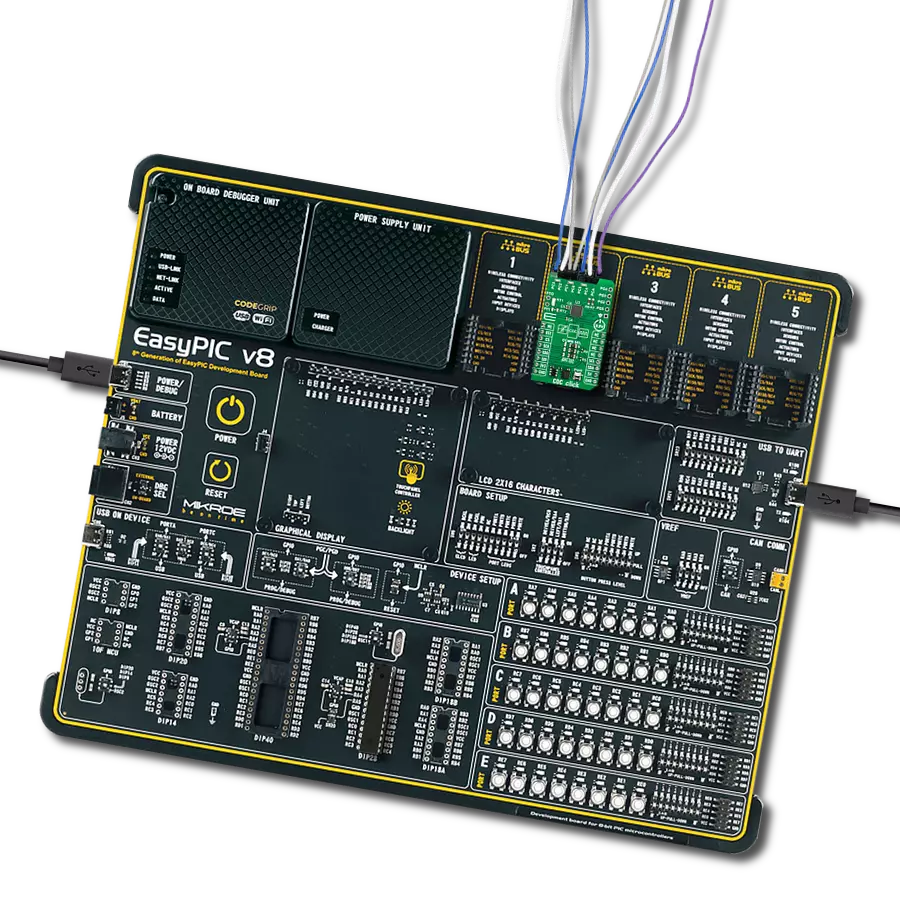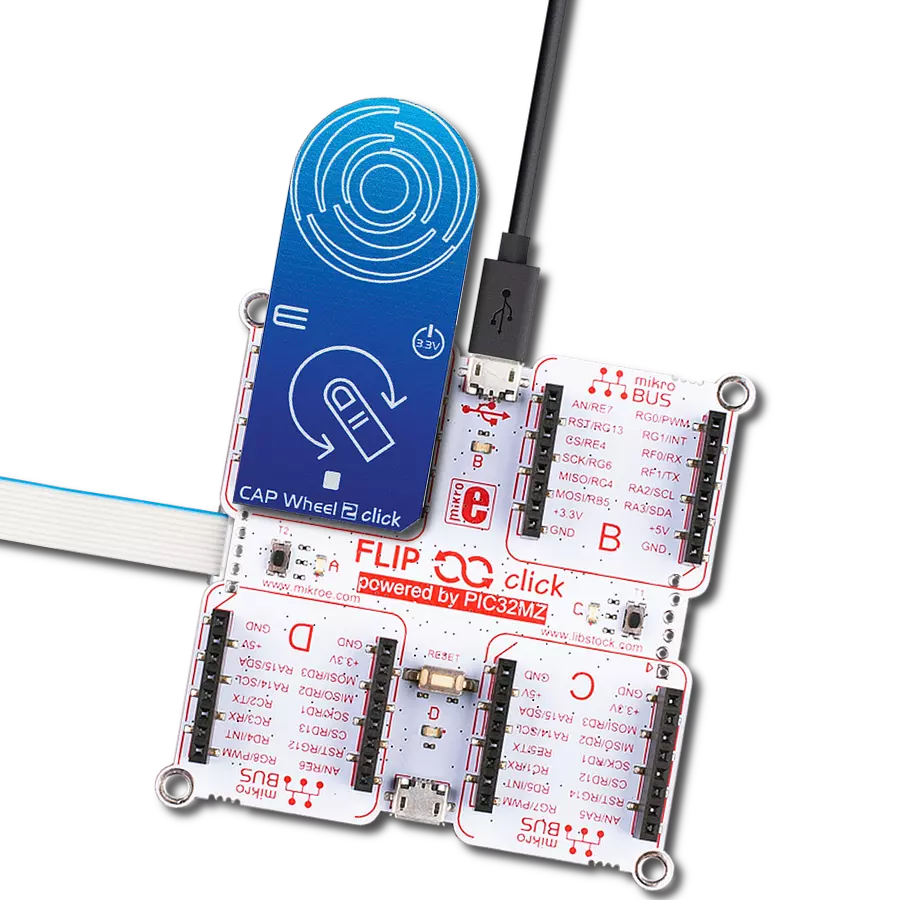Integrate capacitive slider functionalities into your applications and craft immersive experiences that captivate the senses
A
A
Hardware Overview
How does it work?
CAP Slider 2 Click is based on the IQS333, ProxSense® IC, a 9-channel projected (or 7-channel self) capacitive proximity and touch controller from Azoteq. This IC has advanced features such as auto drift compensation, Long proximity range, Automatic adjustment for optimal performance (ATI), two Configurable 11-bit sliders/scroll Slider 2s, and more. These features enable CAP Slider 2 Click to exhibit reliable and accurate touch detection. Capacitive touch sensing is based on detecting a change in capacitance due to the influence of a foreign object. The capacitance of the sensor, also known as the antenna, is measured and monitored, and if a significant change occurs after processing by the
detection integrator, a touch event is acknowledged. CAP Slider 2 Click is designed with these requirements, and electrodes are „Projected XY-cross slider“ shaped. CAP Slider 2 click also contains 8 LEDs whose function can be user-defined. LEDs are connected to PWM LED driver pins on IQS333, so the user can turn LEDs on or off and control illumination using the dimming modes that IQS333 supports. The IQS333 IC interfaces to a master controller via a 3-wire (SDA, SCL, and RDY) serial interface bus that is I2C™ compatible, with a maximum communication speed of 400kbit/s. The host MCU can force communication anytime by pulling the RDY line low. The communication will start directly
following the current conversion cycle. If the watchdog timer terminates the event, the device will reset. After every power-on cycle, the device will recalibrate itself. It will take some time, so it should be considered when building custom applications. MikroElektronika provides libraries and the demo application to be used as a reference for future designs. As mentioned, this Click board™ is I2C™ compatible and uses SCL, SDA, and RDY pins for communication routed to SCL, SDA, and INT pins on mikroBUS™, respectively. Besides that, a CLR pin is available on board which is routed to the RST pin on mikroBUS™ and used to master reset the IC.
Features overview
Development board
Nucleo-64 with STM32F410RB MCU offers a cost-effective and adaptable platform for developers to explore new ideas and prototype their designs. This board harnesses the versatility of the STM32 microcontroller, enabling users to select the optimal balance of performance and power consumption for their projects. It accommodates the STM32 microcontroller in the LQFP64 package and includes essential components such as a user LED, which doubles as an ARDUINO® signal, alongside user and reset push-buttons, and a 32.768kHz crystal oscillator for precise timing operations. Designed with expansion and flexibility in mind, the Nucleo-64 board features an ARDUINO® Uno V3 expansion connector and ST morpho extension pin
headers, granting complete access to the STM32's I/Os for comprehensive project integration. Power supply options are adaptable, supporting ST-LINK USB VBUS or external power sources, ensuring adaptability in various development environments. The board also has an on-board ST-LINK debugger/programmer with USB re-enumeration capability, simplifying the programming and debugging process. Moreover, the board is designed to simplify advanced development with its external SMPS for efficient Vcore logic supply, support for USB Device full speed or USB SNK/UFP full speed, and built-in cryptographic features, enhancing both the power efficiency and security of projects. Additional connectivity is
provided through dedicated connectors for external SMPS experimentation, a USB connector for the ST-LINK, and a MIPI® debug connector, expanding the possibilities for hardware interfacing and experimentation. Developers will find extensive support through comprehensive free software libraries and examples, courtesy of the STM32Cube MCU Package. This, combined with compatibility with a wide array of Integrated Development Environments (IDEs), including IAR Embedded Workbench®, MDK-ARM, and STM32CubeIDE, ensures a smooth and efficient development experience, allowing users to fully leverage the capabilities of the Nucleo-64 board in their projects.
Microcontroller Overview
MCU Card / MCU

Architecture
ARM Cortex-M4
MCU Memory (KB)
128
Silicon Vendor
STMicroelectronics
Pin count
64
RAM (Bytes)
32768
You complete me!
Accessories
Click Shield for Nucleo-64 comes equipped with two proprietary mikroBUS™ sockets, allowing all the Click board™ devices to be interfaced with the STM32 Nucleo-64 board with no effort. This way, Mikroe allows its users to add any functionality from our ever-growing range of Click boards™, such as WiFi, GSM, GPS, Bluetooth, ZigBee, environmental sensors, LEDs, speech recognition, motor control, movement sensors, and many more. More than 1537 Click boards™, which can be stacked and integrated, are at your disposal. The STM32 Nucleo-64 boards are based on the microcontrollers in 64-pin packages, a 32-bit MCU with an ARM Cortex M4 processor operating at 84MHz, 512Kb Flash, and 96KB SRAM, divided into two regions where the top section represents the ST-Link/V2 debugger and programmer while the bottom section of the board is an actual development board. These boards are controlled and powered conveniently through a USB connection to program and efficiently debug the Nucleo-64 board out of the box, with an additional USB cable connected to the USB mini port on the board. Most of the STM32 microcontroller pins are brought to the IO pins on the left and right edge of the board, which are then connected to two existing mikroBUS™ sockets. This Click Shield also has several switches that perform functions such as selecting the logic levels of analog signals on mikroBUS™ sockets and selecting logic voltage levels of the mikroBUS™ sockets themselves. Besides, the user is offered the possibility of using any Click board™ with the help of existing bidirectional level-shifting voltage translators, regardless of whether the Click board™ operates at a 3.3V or 5V logic voltage level. Once you connect the STM32 Nucleo-64 board with our Click Shield for Nucleo-64, you can access hundreds of Click boards™, working with 3.3V or 5V logic voltage levels.
Used MCU Pins
mikroBUS™ mapper
Take a closer look
Click board™ Schematic

Step by step
Project assembly
Software Support
Library Description
This library contains API for Cap Slider 2 Click driver.
Key functions:
capsldr2_write_reg- Generic Write functioncapsldr2_read_reg- Generic Read functioncapsldr2_check_data_ready- Data Ready Check function
Open Source
Code example
The complete application code and a ready-to-use project are available through the NECTO Studio Package Manager for direct installation in the NECTO Studio. The application code can also be found on the MIKROE GitHub account.
/*!
* \file
* \brief CapSlider2 Click example
*
* # Description
* This application could be used for controlling various devices.
*
* The demo application is composed of two sections :
*
* ## Application Init
* Initializes I2C interface, performs the device reset and configurations
* and sets the desired threshold value which determines sensor sensitivity.
*
* ## Application Task
* Checks for data ready and then read capacitance from all channels.
* There are two sliders on the clik board (X and Y).
* X slider selects which LEDs are being activated,
* while Y slider increases/decreases the LEDs intensity.
*
* ## NOTE
* In some cases, the user will need to wait several seconds after the Click initialization
* for the sensor to be stabilized.
*
* \author MikroE Team
*
*/
// ------------------------------------------------------------------- INCLUDES
#include "board.h"
#include "log.h"
#include "capslider2.h"
// ------------------------------------------------------------------ VARIABLES
static capslider2_t capslider2;
static log_t logger;
// ------------------------------------------------------ APPLICATION FUNCTIONS
uint32_t wheel_avrg1;
uint32_t wheel_avrg2;
uint16_t out_val;
uint8_t out_mode;
uint8_t cnt;
void horizontal_check( )
{
out_val = ((wheel_avrg1 / cnt) / 142.1) - 5;
out_mode = CAPSLDR2_LED_NUMBER;
}
void vertical_check( )
{
out_val = (2047 - (wheel_avrg1 / cnt)) / 147.4;
out_mode = CAPSLDR2_LED_INTENSITY;
}
void application_init ( void )
{
log_cfg_t log_cfg;
capslider2_cfg_t cfg;
/**
* Logger initialization.
* Default baud rate: 115200
* Default log level: LOG_LEVEL_DEBUG
* @note If USB_UART_RX and USB_UART_TX
* are defined as HAL_PIN_NC, you will
* need to define them manually for log to work.
* See @b LOG_MAP_USB_UART macro definition for detailed explanation.
*/
LOG_MAP_USB_UART( log_cfg );
log_init( &logger, &log_cfg );
log_info( &logger, "---- Application Init ----" );
// Click initialization.
capslider2_cfg_setup( &cfg );
CAPSLIDER2_MAP_MIKROBUS( cfg, MIKROBUS_1 );
capslider2_init( &capslider2, &cfg );
Delay_ms ( 500 );
cnt = 0;
wheel_avrg1 = 0;
wheel_avrg2 = 0;
capsldr2_reset( &capslider2 );
Delay_ms ( 500 );
capsldr2_enable_chann( &capslider2, CAPSLDR2_CH0_PROX_EN | CAPSLDR2_CH1_EN | CAPSLDR2_CH2_EN | CAPSLDR2_CH3_EN | CAPSLDR2_CH4_EN | CAPSLDR2_CH5_EN | CAPSLDR2_CH6_EN | CAPSLDR2_CH7_EN | CAPSLDR2_CH8_EN | CAPSLDR2_CH9_EN );
capsldr2_config( &capslider2 );
capsldr2_set_threshold( &capslider2, 0x04 );
Delay_ms ( 1000 );
Delay_ms ( 1000 );
Delay_ms ( 1000 );
Delay_ms ( 1000 );
log_printf( &logger, "CAP Slider 2 is initialized\r\n" );
}
void application_task ( void )
{
uint16_t data_wheel1;
uint16_t data_wheel2;
uint8_t ready_check;
ready_check = capsldr2_check_data_ready( &capslider2 );
if (ready_check == CAPSLDR2_DATA_READY)
{
capsldr2_get_data( &capslider2, &data_wheel1, &data_wheel2 );
wheel_avrg1 += data_wheel1;
wheel_avrg2 += data_wheel2;
cnt++;
}
if (cnt == 1)
{
if ((wheel_avrg2 / cnt) > 1800)
{
horizontal_check( );
capsldr2_set_output( &capslider2, out_val, out_mode );
}
else if (((wheel_avrg2 / cnt) < 1650) && ((wheel_avrg2 / cnt) > 1000))
{
vertical_check( );
capsldr2_set_output( &capslider2, out_val, out_mode );
}
wheel_avrg1 = 0;
wheel_avrg2 = 0;
cnt = 0;
}
}
int main ( void )
{
/* Do not remove this line or clock might not be set correctly. */
#ifdef PREINIT_SUPPORTED
preinit();
#endif
application_init( );
for ( ; ; )
{
application_task( );
}
return 0;
}
// ------------------------------------------------------------------------ END
Additional Support
Resources
Category:Capacitive


































